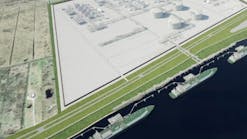DOI releases revised proposal to regulate hydraulic fracturing
The US Department of the Interior released a revised proposal to regulate hydraulic fracturing on public and Indian lands that it said would maintain important safety standards, improve integration with existing state and tribal rules, and increase flexibility for oil and gas producers.
Oil and gas trade associations immediately said the new proposal unnecessarily duplicates state regulations that are already effective—the same criticism they had of DOI’s initial draft proposal in 2012, which was subsequently withdrawn for revisions. Comments on the new proposal will be accepted for 30 days.
DOI said the new draft proposal contains the original’s three main components: requiring operators to disclose chemicals they use in fracing activities on public lands; improving well bore integrity assurances to verify that frac fluids do not contaminate groundwater; and confirming that oil and gas operators have a water management plan for handling flowback fluids.
It said the new draft proposal addresses many of more than 177,000 public comments that the US Bureau of Land Management received during the first proposal’s 120-day public comment period last fall, as well as other feedback from eight forums and other meetings held with American Indian tribal representatives.
DOI said the new proposal revises the array of tools operators may use to show water is being protected, and provides more guidance on trade secret disclosure, while providing additional flexibility for meeting these objectives.
Variance process
It said while the revised draft still seeks to establish baseline environmental safeguards across all public and Indian lands, it also complements efforts of Colorado, Wyoming, North Dakota, Texas, and other states which regulate fracing. The new proposal includes a variance process that allows for deferring to states and tribes which already have standards that meet or exceed those proposed by this rule, DOI noted.
It said while BLM is not proposing a material change in the provision allowing flowback fluids to be stored either in tanks or lined pits, comments are being sought on costs and benefits of requiring those fluids to be stored only in closed tanks.
“We know from experience that hydraulic fracturing and horizontal drilling methods can be used safely and effectively, employing many of the best management practices reflected in this draft rule,” BLM Principal Deputy Director Neil Kornze said on May 16 when the revised draft proposal was released.
“Our thorough review of all the comments convinced us that we could maintain a strong level of protection of health, safety, and the environment while allowing for increased flexibility and reduced regulatory duplication,” Kornze said.
But oil and gas trade associations and related groups quickly found problems with the new draft proposal. “States have led the way in regulating hydraulic fracturing operations while protecting communities and the environment for decades,” American Petroleum Institute Upstream and Industry Operations Director Erik Milito said on May 16.
“While changes to the proposed rule attempt to better acknowledge the state role, BLM has yet to answer the question why [it] is moving forward with these requirements in the first place,” he said.
Solves no problems
“Unfortunately, the rule solves no existing problem, but creates additional burdens for independent producers and state regulators,” Independent Petroleum Association of America Pres. Barry Russell said. “If [DOI] believes there are gaps in state regulations of oil and gas, [it] should work with the states to implement changes rather than imposing a costly and burdensome rule on independent producers.”
IPAA plans to ask that the comment period be extended, and looks forward to meeting with BLM to discuss the new draft, he added.
Karen A. Harbert, president of the US Chamber of Commerce’s Institute for 21st Century Energy, said the new proposal itself points out duplications that would exist, saying “operators with leases on federal lands must comply with both BLM’s regulations and with state operating requirements, including state permitting and notice requirements to the extent they do not conflict with BLM regulations.”
Ross Eisenberg, vice-president of energy and resources policy at the National Association of Manufacturers, meanwhile, stated, “Reactive federal regulations can harm gains resulting from increased exploration of shale oil and gas. Limiting the comment period for this rule to only 30 days is simply not enough time to evaluate such complex regulations. Shale development represents a major energy advantage that could create a million manufacturing jobs by 2025.”
Kathleen Sgamma, vice-president of government and public affairs at the Western Energy Alliance in Denver, said, “While the current rule is better than the first impractical rule, DOI still has not justified [it] from an economic or scientific point of view. It continues to second guess states and tribes, and will hurt job creation and economic growth in western communities.”
Amy Farrell, vice-president of regulatory affairs at America’s Natural Gas Alliance, said the organization of larger gas producers was encouraged that the Obama administration revisited its original proposal and apparently made some favorable changes, including accounting for states’ expertise and work. “We will reserve judgment on the proposal more broadly until we have had a chance to thoroughly evaluate it,” she said.
Contact Nick Snow at [email protected].

Nick Snow
NICK SNOW covered oil and gas in Washington for more than 30 years. He worked in several capacities for The Oil Daily and was founding editor of Petroleum Finance Week before joining OGJ as its Washington correspondent in September 2005 and becoming its full-time Washington editor in October 2007. He retired from OGJ in January 2020.


